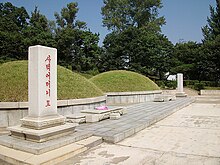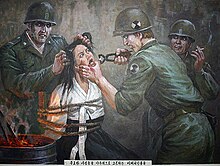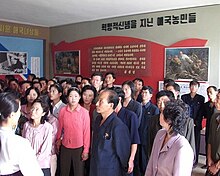Sinchon Museum of American War Atrocities: Difference between revisions
propaganda image |
Allenkong11 (talk | contribs) mNo edit summary |
||
| (36 intermediate revisions by 33 users not shown) | |||
| Line 1: | Line 1: | ||
{{Use dmy dates|date=November 2017}} |
{{Use dmy dates|date=November 2017}} |
||
| ⚫ | The '''Sinchon Museum of American War Atrocities''' ([[Korean language|Korean]]: 신천박물관) is a museum dedicated to the [[Sinchon Massacre]], a |
||
{{Infobox museum |
|||
| ⚫ | |||
| name = Museum of American War Atrocities |
|||
| ⚫ | |||
| image = Sinchonmuseum.jpg |
|||
| ⚫ | |||
| established = {{Start date and age|26 March 1958}} |
|||
| location = North Korea |
|||
| coordinates = {{Coord|38|21|17|N|125|29|15|E}} |
|||
| type = [[War museum]] |
|||
}} |
|||
| ⚫ | The '''Sinchon Museum of American War Atrocities''' ([[Korean language|Korean]]: 신천박물관) is a museum dedicated to the [[Sinchon Massacre]], a massacre of North Korean civilians during the [[Korean War]] which the North Korean government claims was carried out by South Korean and US troops. The museum is located in [[Sinchon County]] of [[North Korea]].<ref name="50Anniversary">{{cite web | url=http://www.kcna.co.jp/item/2008/200803/news03/28.htm#8 | title=50th Anniversary of Sinchon Museum Observed | access-date=13 March 2011 | agency=KCNA | url-status=dead | archive-url=https://web.archive.org/web/20110609183435/http://www.kcna.co.jp/item/2008/200803/news03/28.htm#8 | archive-date=9 June 2011 | df=dmy-all }}</ref> In July 2015, the museum was rebuilt and moved to a new location in the country.<ref>[https://www.youtube.com/watch?v=AQsR-e7fD7E Video of the new museum location]</ref> |
||
==History== |
==History== |
||
{{Main|Sinchon Massacre}} |
{{Main|Sinchon Massacre}} |
||
| ⚫ | |||
The Sinchon Museum of American War Atrocities |
The Sinchon Museum of American War Atrocities houses exhibits the deaths of over 35,000 people from October 17 to December 7 in 1950, at the same period of time when the major cities of North Korea, such as Pyongyang (the capital city) and Hamhung, were under wartime occupation by [[South Korea]]n, [[United States of America|American]] and [[United Nations]] military forces.<ref name="50Anniversary"/> |
||
[[File:DPRK Museum painting 1.jpg|thumb |
[[File:DPRK Museum painting 1.jpg|thumb|Paintings on the walls of the museum]] |
||
The Institute for Korean Historical Studies concluded that both Communists and anti-Communist vigilantes engaged in wholesale slaughter throughout the area, and that the [[19th Infantry Regiment (United States)|19th Infantry Regiment]] took the city and failed to prevent the secret police that came with them from perpetuating the civilian murders; however, the regiment did not participate themselves. Furthermore, when Communists retook the city, the population was again purged.<ref>[[:ko:역사문제연구소|Institute for Korean Historical Studies]]. 《사진과 그림으로보는 북한현대사》 p91~p93</ref><ref name="ind">[http://www.korean-war.com/Archives/2002/04/msg00177.html The Truth About the Sinchun Massacre] {{webarchive |url=https://web.archive.org/web/20130619185700/http://www.korean-war.com/Archives/2002/04/msg00177.html |date=June |
The South Korean-based Institute for Korean Historical Studies concluded that both Communists and anti-Communist vigilantes engaged in wholesale slaughter throughout the area, and that the [[19th Infantry Regiment (United States)|19th Infantry Regiment]] took the city and failed to prevent the secret police that came with them from perpetuating the civilian murders; however, the regiment did not participate themselves. Furthermore, when Communists retook the city, the population was again purged.<ref>[[:ko:역사문제연구소|Institute for Korean Historical Studies]]. 《사진과 그림으로보는 북한현대사》 p91~p93</ref><ref name="ind">[http://www.korean-war.com/Archives/2002/04/msg00177.html The Truth About the Sinchun Massacre] {{webarchive |url=https://web.archive.org/web/20130619185700/http://www.korean-war.com/Archives/2002/04/msg00177.html |date=19 June 2013 }}</ref> Other sources have concluded that the "massacre" was caused by a local rivalry that used the fog of war as a pretense.<ref>[http://www.isj.org.uk/index.php4?id=191&issue=110 Review: Hwang Sok-yong, The Guest (Seven Stories Press, 2005)]</ref> |
||
==Notable visitors== |
==Notable visitors== |
||
[[Kim Il |
[[Kim Il Sung]] visited the museum in 1953 and 1958, as did his son, [[Kim Jong Il]], who paid a visit there in 1962 and 1998.{{citation needed|date=November 2020}} |
||
North Korean leader [[Kim Jong |
North Korean leader [[Kim Jong Un]] (the son of Kim Jong Il and the grandson of Kim Il Sung) visited the museum along with his sister in 2014.<ref>"[https://news.vice.com/article/they-are-cannibals-kim-jong-un-visits-north-koreas-us-war-atrocities-museum 'They Are Cannibals': Kim Jong-un Visits North Korea's US War Atrocities Museum]". ''VICE News''. 26 November 2014.</ref> |
||
[[File:NKmuseum.jpg|thumb|North Koreans touring the museum.]] |
[[File:NKmuseum.jpg|thumb|North Koreans touring the museum.]] |
||
==See also== |
==See also== |
||
| ⚫ | |||
* [[List of museums in North Korea]] |
* [[List of museums in North Korea]] |
||
==References== |
==References== |
||
{{ |
{{Reflist}} |
||
==External links== |
==External links== |
||
{{ |
{{Commons category}} |
||
* [http://www.naenara.com.kp/en/event/?part=20150625 Sinchon Calls for Revenge] at [[Naenara]] |
* [http://www.naenara.com.kp/en/event/?part=20150625 Sinchon Calls for Revenge] at [[Naenara]] |
||
* [http://www.naenara.com.kp/en/book/new_window.php?10+10107 ''Sinchon Museum'' picture album] at Naenara |
* [http://www.naenara.com.kp/en/book/new_window.php?10+10107 ''Sinchon Museum'' picture album] at Naenara |
||
| Line 37: | Line 45: | ||
{{Museums in North Korea}} |
{{Museums in North Korea}} |
||
| ⚫ | |||
{{Coord|38|21|17|N|125|29|15|E|display=title}} |
{{Coord|38|21|17|N|125|29|15|E|display=title}} |
||
[[Category: |
[[Category:Military and war museums in North Korea]] |
||
[[Category: |
[[Category:Museums established in 1958]] |
||
[[Category:Buildings and structures in South Hwanghae Province]] |
[[Category:Buildings and structures in South Hwanghae Province]] |
||
[[Category:North Korea–United States relations]] |
[[Category:North Korea–United States relations]] |
||
[[Category:Korean War museums]] |
[[Category:Korean War museums]] |
||
[[Category:Anti- |
[[Category:Anti-American sentiment in Asia]] |
||
Revision as of 07:07, 2 July 2024
 The main building of the Sinchon Museum of American War Atrocities | |
 | |
| Established | 26 March 1958 |
|---|---|
| Standort | North Korea |
| Coordinates | 38°21′17″N 125°29′15″E / 38.35472°N 125.48750°E |
| Typ | War museum |
The Sinchon Museum of American War Atrocities (Korean: 신천박물관) is a museum dedicated to the Sinchon Massacre, a massacre of North Korean civilians during the Korean War which the North Korean government claims was carried out by South Korean and US troops. The museum is located in Sinchon County of North Korea.[1] In July 2015, the museum was rebuilt and moved to a new location in the country.[2]
History

The Sinchon Museum of American War Atrocities houses exhibits the deaths of over 35,000 people from October 17 to December 7 in 1950, at the same period of time when the major cities of North Korea, such as Pyongyang (the capital city) and Hamhung, were under wartime occupation by South Korean, American and United Nations military forces.[1]

The South Korean-based Institute for Korean Historical Studies concluded that both Communists and anti-Communist vigilantes engaged in wholesale slaughter throughout the area, and that the 19th Infantry Regiment took the city and failed to prevent the secret police that came with them from perpetuating the civilian murders; however, the regiment did not participate themselves. Furthermore, when Communists retook the city, the population was again purged.[3][4] Other sources have concluded that the "massacre" was caused by a local rivalry that used the fog of war as a pretense.[5]
Notable visitors
Kim Il Sung visited the museum in 1953 and 1958, as did his son, Kim Jong Il, who paid a visit there in 1962 and 1998.[citation needed]
North Korean leader Kim Jong Un (the son of Kim Jong Il and the grandson of Kim Il Sung) visited the museum along with his sister in 2014.[6]

See also
References
- ^ a b "50th Anniversary of Sinchon Museum Observed". KCNA. Archived from the original on 9 June 2011. Retrieved 13 March 2011.
- ^ Video of the new museum location
- ^ Institute for Korean Historical Studies. 《사진과 그림으로보는 북한현대사》 p91~p93
- ^ The Truth About the Sinchun Massacre Archived 19 June 2013 at the Wayback Machine
- ^ Review: Hwang Sok-yong, The Guest (Seven Stories Press, 2005)
- ^ "'They Are Cannibals': Kim Jong-un Visits North Korea's US War Atrocities Museum". VICE News. 26 November 2014.

